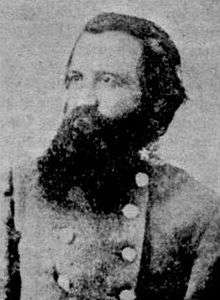James Argyle Smith
| James Argyle Smith | |
|---|---|
 James Argyle Smith, Brigadier General in the Confederate Army | |
| Born |
July 1, 1831 Maury County, Tennessee |
| Died |
December 6, 1901 (aged 70) Jackson, Mississippi |
| Place of burial | Greenwood Cemetery (Jackson, Mississippi) |
| Allegiance |
|
| Service/branch |
|
| Rank |
|
| Battles/wars |
Sioux Expedition |
James Argyle Smith (July 1, 1831 – December 6, 1901) was a United States Army officer, and a graduate of West Point. He is known for being a Confederate brigadier general during the Civil War, his works in the educational system in Mississippi, and in the Bureau of Indian Affairs.[1]
Early life and career
James Smith was born and raised in Tennessee as a boy. He went to West Point, graduated in 1853, and became a second lieutenant in the infantry.[2] Smith served in various posts in the west including the Jefferson Barracks Military Post. Smith fought at the Battle of Ash Hollow against the Sioux in 1855.[3] Then from 1857 to 1858, Smith fought in the Utah War against the Mormons.[3] One year after returning from the Utah War Smith was promoted to a first lieutenant. In May 1861 Smith resigned his commission to join the Confederate Army.[4]
Civil War service
Smith joined the Confederate Army in 1861 with the rank of lieutenant.[4] In March 1862 he became a major and the adjutant-general to General Leonidas Polk.[5] At the Battle of Shiloh Smith became the lieutenant-colonel of the Second Tennessee Infantry Regiment.[3] General Bushrod Johnson commended Smith on his bravery at the Battle of Perryville and he was put in command of the 5th Confederate Infantry.[5] His bravery was also noticed at the Battle of Murfreesboro by both General Cleburne and General Leonidas Polk.[3] After his performance at the Battle of Chickamauga and the praise he received from Polk, Smith was promoted to brigadier general.[5] At the Battle of Missionary Ridge General Smith attacked Sherman's flank preventing the Union Army of blocking off General Bragg's retreat.[3] During the Battle of Missionary Ridge Smith was shot through both thighs while leading his men.[4] After recovering Smith fought at the Battle of Atlanta where his brigade captured fifteen artillery pieces. During this battle he was wounded again.[4] He was under the command of Cleburne at the Second Battle of Franklin, and after Cleburne's death Smith took over command at Nashville.[5] General Smith and General William Bate led Cheatham's corps at the Battle of Bentonville.[3]
Postbellum career and death
After starting a farm in Mississippi Smith was elected the Mississippi State Superintendent of Public Education from 1878 to 1886.[1] He then became an agent of the Bureau of Indian Affairs from 1893 to 1897.[1] He later become the Marshal of the Supreme Court of Mississippi.[1] James Argyle Smith died on December 6, 1901 in Jackson, Mississippi and was buried at the Greenwood Cemetery.[4]
See also
Notes
- 1 2 3 4 Thomas William Herringshaw's Herringshaw's National Library of American Biography: Contains Thirty-five Thousand Biographies of the Acknowledged Leaders of Life and Thought of the United States; Illustrated with Three Thousand Vignette Portraits (1914) pg. 249
- ↑ Francis Bernard Heitman's Historical Register of the United States Army: From Its Organization, September 29, 1789, to September 29, 1889 (1890) pg. 599
- 1 2 3 4 5 6 Clement Anselm Evans's Confederate Military History: A Library of Confederate States History (1899) pgs. 269–70
- 1 2 3 4 5 Jack D. Welsh's Medical Histories of Confederate Generals (1999) pg. 200
- 1 2 3 4 Ezra J. Warner's Generals in Gray: Lives of the Confederate Commanders (1959) pgs. 281–82
References
- Eicher, John H., and David J. Eicher, Civil War High Commands. Stanford: Stanford University Press, 2001. ISBN 978-0-8047-3641-1.
- Herringshaw, Thomas William. Herringshaw's National Library of American Biography: Contains Thirty-five Thousand Biographies of the Acknowledged Leaders of Life and Thought of the United States; Illustrated with Three Thousand Vignette Portraits Chicago: American Publishers Association, 1914. pg. 249
- Heitman, Francis Bernard. Historical Register of the United States Army: From Its Organization, September 29, 1789, to September 29, 1889 Washington, DC: The National Tribune, 1890. pg. 599
- Evans, Clement A., ed. Confederate Military History: A Library of Confederate States History. 12 vols. Atlanta: Confederate Publishing Company, 1899. OCLC 833588. Retrieved January 20, 2011. Volume: 7. Wheeler, Joseph; Alabama. Hooker, C. E.; Mississippi.
- Sifakis, Stewart. Who Was Who in the Civil War. New York: Facts On File, 1988. ISBN 978-0-8160-1055-4.
- Jack D. Welsh's Medical Histories of Confederate Generals (1999) pg. 200
- Warner, Ezra J. Generals in Gray: Lives of the Confederate Commanders. Baton Rouge: Louisiana State University Press, 1959. ISBN 978-0-8071-0823-9.) pgs. 281–82